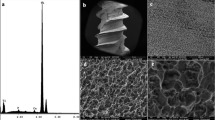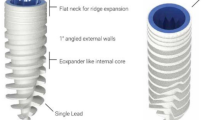Abstract
Objectives
The objective of this study is to compare bone-to-implant contact (BIC) between implants inserted at high torque due to under-drilling of the crestal bone to those inserted at low torque due to over-drilling of the crestal bone.
Materials and methods
Forty implants with diameters of 3.75 mm (group A) or 3.55 mm (group B) were inserted in the proximal tibiae of NZW rabbits in two separate surgeries on day 0 or 21. Osteotomy of the crestal bone was finalized with a 3.65-mm drill. In group A, implants were inserted at torque ≥35 Ncm (under-drilling) and in group B with torque <10 Ncm (over-drilling). Implants and their surrounding bone were retrieved on day 42, thus creating 3- and 6-week observation periods, processed for non-decalcified histology and stained with toluidine blue. Crestal BIC (c-BIC) and total BIC (t-BIC) were measured. Wilcoxon test was used to evaluate differences between groups.
Results
Three weeks post-surgery, the mean c-BIC in group A was 16.3 ± 3.3 vs 31.5 ± 3.4 % in group B (P < 0.05). At 6 weeks, a similar trend was observed (group A: 28.7 ± 3.6 %; group B: 38.4 ± 4.9 %) (P > 0.05). No differences in t-BIC were noted at 3 weeks and at 6 weeks between the groups.
Conclusions
Insertion of implants with an over-drilling protocol of the crestal aspect of the osteotomy resulted in increased short-term crestal bone-to-implant contact.
Clinical relevance
Insertion of implants with a high torque following an under-drilling protocol, commonly used for immediate loading, may reduce crestal bone-to-implant contact at early healing stages.







Similar content being viewed by others
References
Adell R, Lekholm U, Rockler B, Brånemark PI (1981) A 15-year study of osseointegrated implants in the treatment of the edentulous jaw. Int J Oral Surg 10:387–416
Søballe K, Brockstedt-Rasmussen H, Hansen ES, Bünger C (1992) Hydroxyapatite coating modifies implant membrane formation. Controlled micromotion studied in dogs. Acta Orthop Scand 63:128–140
Szmukler-Moncler S, Piattelli A, Favero GA, Dubruille JH (2000) Considerations preliminary to the application of early and immediate loading protocols in dental implantology. Clin Oral Implants Res 11:12–25
Trisi P, Perfetti G, Baldoni E, Berardi D, Colagiovanni M, Scogna G (2009) Implant micro-motion is related to peak insertion torque and bone density. Clin Oral Implants Res 20:467–471
Trisi P, De Benedittis S, Perfetti G, Berardi D (2011) Primary stability, insertion torque and bone density of cylindric implant ad modum Branemark: is there a relationship? An in vitro study. Clin Oral Implants Res 22:567–570
Ottoni JM, Oliveira ZF, Mansini R, Cabral AM (2005) Correlation between placement torque and survival of single-tooth implants. Int J Oral Maxillofac Implants 20:769–776
Neugebauer J, Traini T, Thams U, Piatelli A, Zöller JE (2006) Peri-implant bone organization under immediate loading state. Circularly polarized light analyses: a minipig study. J Periodontol 77:152–160
Turkyilmaz I, Aksoy U, McGlumphy EA (2008) Two alternative surgical techniques for enhancing primary implant stability in the posterior maxilla: a clinical study including bone density, insertion torque and resonance frequency analysis data. Clin Implant Dent Relat Res 10:231–237
Nkenke E, Kloss F, Wiltfang J, Schultze- Mosgau S, Radespiel-Tro¨ger M, Loos K (2002) Histomorphometric and fluorescence microscopic analysis of bone remodeling after installation of implants using an osteotome technique. Clin Oral Implants Res 13:595–602
Bashutski JD, D’Silva NJ, Wang HL (2009) Implant pressure necrosis: current understanding and case report. J Periodontol 80:700–704
O’Sullivan D, Sennerby L, Meredith N (2000) Measurements comparing the initial stability of five designs of dental implants: a human cadaver study. Clin Implant Dent Relat Res 2:85–92
Donath K (1985) The diagnostic value of the new method for the study of undecalcified bones and teeth with attached soft tissue (Säge-Schliff (sawing and grinding) technique). Pathol Res Pract 179(6):631–633
Berglundh T, Abrahamsson I, Lang NP, Lindhe J (2003) De novo alveolar bone formation adjacent to endosseous implants. Clin Oral Implants Res 14:251–62
Abrahamsson I, Berglundh T, Linder E, Lang NP, Lindhe J (2004) Early bone formation adjacent to rough and turned endosseous implant surfaces. An experimental study in the dog. Clin Oral Implants Res 15:381–392
Duyck J, Roesems R, Cardoso MV, Ogawa T, De Villa CG, Vandamme K (2015) Effect of insertion torque on titanium implant osseointegration: an animal experimental study. Clin Oral Implants Res 26:191–196
Halldin A, Jimbo R, Johansson CB, Wennerberg A, Jacobsson M, Albrektsson T, Hansson S (2011) The effect of static bone strain on implant stability and bone remodeling. Bone 49:783–789
Krassas GE, Papadopoulou P (2001) Oestrogen action on bone cells. J Musculoskelet Neuronal Interact 2:143–151
Coelho PG, Marin C, Teixeira HS, Campos FE, Gomes JB, Guastaldi F, Anchieta RB, Silveira L, Bonfante EA (2013) Biomechanical evaluation of undersized drilling on implant biomechanical stability at early implantation times. J Oral Maxillofac Surg 71:e69–75
Masaki C, Schneider GB, Zaharias R, Seabold D, Stanford C (2005) Effects of implant surface microtopography on osteoblast gene expression. Clin Oral Implants Res 16:650–656
Schneider GB, Perinpanayagam H, Clegg M, Zaharias R, Seabold D, Keller J, Stanford C (2003) Implant surface roughness affects osteoblast gene expression. J Dent Res 82:372–376
Abrahamsson I, Berglundh T (2006) Tissue characteristics at microthreaded implants: an experimental study in dogs. Clin Implant Dent Relat Res 8:107–113
Lee DW, Choi YS, Park KH, Kim CS, Moon IS (2007) Effect of microthread on the maintenance of marginal bone level: a 3-year prospective study. Clin Oral Implants Res 18:465–470
Author information
Authors and Affiliations
Corresponding author
Ethics declarations
This study protocol was approved by the ethical committee for Animal Experimentation of Harlan Laboratories Ltd. (Kiryat Weizmann, Rehovot, Israel) No. IL-12-02-032.
Conflict of interest
Author A declares that he has no conflict of interest. Author B declares that he serves as an external advisor of Alpha Biotech Ltd. Author C declares that he has no conflict of interest. Author D declares that he has no conflict of interest. Author E declares that he has no conflict of interest. Author F declares that he serves as an external advisor of Alpha Biotech Ltd.
Funding
This study was funded by Alpha Biotech Ltd. (Petah Tikva, Israel) (grant number 0601914231). Grant recipients: Ofer Moses and Zeev Ormianer.
Ethical approval
All applicable international, national, and/or institutional guidelines for the care and use of animals were followed.
Informed consent
This study is an animal model study. For this type of study, informed consent is not required.
Rights and permissions
About this article
Cite this article
Cohen, O., Ormianer, Z., Tal, H. et al. Differences in crestal bone-to-implant contact following an under-drilling compared to an over-drilling protocol. A study in the rabbit tibia. Clin Oral Invest 20, 2475–2480 (2016). https://doi.org/10.1007/s00784-016-1765-8
Received:
Accepted:
Published:
Issue Date:
DOI: https://doi.org/10.1007/s00784-016-1765-8




